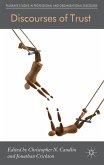We live in world increasingly shaped by risk, a fact underscored by recent events in the financial markets, science and technology, environmental policy and biosecurity, law enforcement and criminal justice. Risk assessment has become a central concern of governments, organisations and the professions, and the communication of risk is a crucial part of professional work. Exploring how risk is discursively constructed across these domains is therefore central to our understanding of how professional practice affects people's lives. Communicating Risk takes up this challenge, with contributions from leading researchers and practitioners that examine key issues of risk communication across diverse professional domains.
Review 1 - Prof Claire Penn, University of the Witwatersrand
General
I have read the prospectus provided to me as well as the Table of contents
Risk is a fascinating topic in the modern world and one which attracts the interest of multiple disciplines. This project specifically wishes to explores risk as a global phenomenon in an inter- domain and inter-site perspective. It more than adequately engages with recent scholarship and I believe will make be a lasting resource to those interested in discourse as well as to global practitioners in multiple domains. This probably therefore qualifies either as a handbook or an upper level text. If the former it probably could be extended in length.
Proposal
The challenge for a text of this nature is of course to select the focus and to integrate the numerous contributions into cohesive themes.
This 20- chapter proposed volume is carefully and logically organized . There is definitely an international feel to this volume and the authors represent a variety of different disciplines and perspectives. The prospectus is explicit , detailed and extremely well motivated . Target audiences are clearly described and I believe there is a very realistic delineation of possible interested readers
I really like the detailed description of content and organization and am confident that the main aspects of risk highlighted will enable the contributing authors to frame cohesive chapters which will link well to the overarching goals of the volume .
The interface between practice and research is a critical part of this enterprise and I believe that there is a good balance here which should appeal to students and practitioners.
In terms of the chapters proposed, I see immediately the challenge to any Editors - one of balancing the sections and of deciding how to manage potential overlaps. In relation to the latter, I am confident that the editors will be well placed to handle this in editorial comments. In terms of balance at present, there are between three to five chapters in each section . Though necessarily distinct there are potential areas of overlap which could be highlighted or possibly subsumed into a separate section. My own particular bias may show here . As my specialization is in the area of health I have seen the need over the past decade for much more communication between domains and disciplines within the health sector for example. For instance I have a feeling that the developmental aspect of risk might be interesting to explore and I do feel that some more perspectives on intercultural communication might be useful theme to highlight.
One of the areas that I have encountered for example has been in genetic counselling and conveying risk which might be an interesting aspect to explored as it very clearly highlights some of the broader themes alluded to in the prospectus. The other issues , has been the high risk taking of adolescents especially in the light of the HIV Aids epidemic in sub- Saharan Africa and its demographic profile. A possible link presents itself for foregrounding potential differences between the global north and global south in risk identification and management and some of the gender differences that present themselves in such data .
Sections 1 and 2 in this regard and obviously Sections 3 and 5 on mediating risk has overlap here have no doubt that such themes are already present. And I applaud the proposed focus on risk is a social and cultural category and a construct contextually located.
The selected contributors appear eminently suited for this volume - their collective experience and records suggest that this will be a profoundly fruitful collaboration . The main editors (whose work is well known to me) are in my opinion ideally suited for this publication. I enjoyed reading the abstracts of each intended contribution and see their potential to link well to the overarching themes of the book and to each other .
Market and Competition
The edit
General
I have read the prospectus provided to me as well as the Table of contents
Risk is a fascinating topic in the modern world and one which attracts the interest of multiple disciplines. This project specifically wishes to explores risk as a global phenomenon in an inter- domain and inter-site perspective. It more than adequately engages with recent scholarship and I believe will make be a lasting resource to those interested in discourse as well as to global practitioners in multiple domains. This probably therefore qualifies either as a handbook or an upper level text. If the former it probably could be extended in length.
Proposal
The challenge for a text of this nature is of course to select the focus and to integrate the numerous contributions into cohesive themes.
This 20- chapter proposed volume is carefully and logically organized . There is definitely an international feel to this volume and the authors represent a variety of different disciplines and perspectives. The prospectus is explicit , detailed and extremely well motivated . Target audiences are clearly described and I believe there is a very realistic delineation of possible interested readers
I really like the detailed description of content and organization and am confident that the main aspects of risk highlighted will enable the contributing authors to frame cohesive chapters which will link well to the overarching goals of the volume .
The interface between practice and research is a critical part of this enterprise and I believe that there is a good balance here which should appeal to students and practitioners.
In terms of the chapters proposed, I see immediately the challenge to any Editors - one of balancing the sections and of deciding how to manage potential overlaps. In relation to the latter, I am confident that the editors will be well placed to handle this in editorial comments. In terms of balance at present, there are between three to five chapters in each section . Though necessarily distinct there are potential areas of overlap which could be highlighted or possibly subsumed into a separate section. My own particular bias may show here . As my specialization is in the area of health I have seen the need over the past decade for much more communication between domains and disciplines within the health sector for example. For instance I have a feeling that the developmental aspect of risk might be interesting to explore and I do feel that some more perspectives on intercultural communication might be useful theme to highlight.
One of the areas that I have encountered for example has been in genetic counselling and conveying risk which might be an interesting aspect to explored as it very clearly highlights some of the broader themes alluded to in the prospectus. The other issues , has been the high risk taking of adolescents especially in the light of the HIV Aids epidemic in sub- Saharan Africa and its demographic profile. A possible link presents itself for foregrounding potential differences between the global north and global south in risk identification and management and some of the gender differences that present themselves in such data .
Sections 1 and 2 in this regard and obviously Sections 3 and 5 on mediating risk has overlap here have no doubt that such themes are already present. And I applaud the proposed focus on risk is a social and cultural category and a construct contextually located.
The selected contributors appear eminently suited for this volume - their collective experience and records suggest that this will be a profoundly fruitful collaboration . The main editors (whose work is well known to me) are in my opinion ideally suited for this publication. I enjoyed reading the abstracts of each intended contribution and see their potential to link well to the overarching themes of the book and to each other .
Market and Competition
The edit








